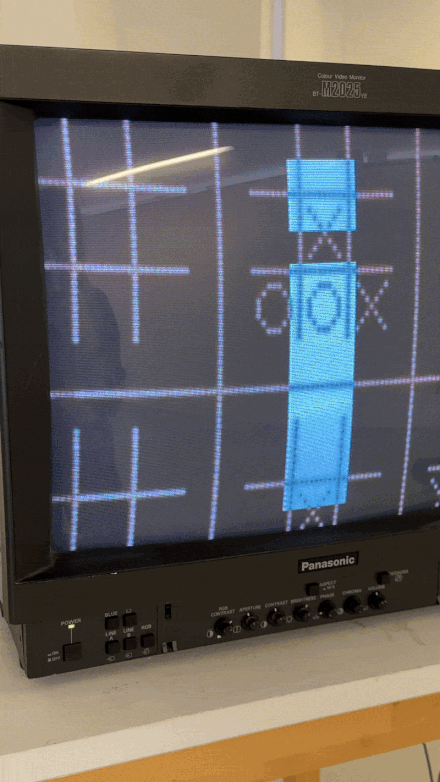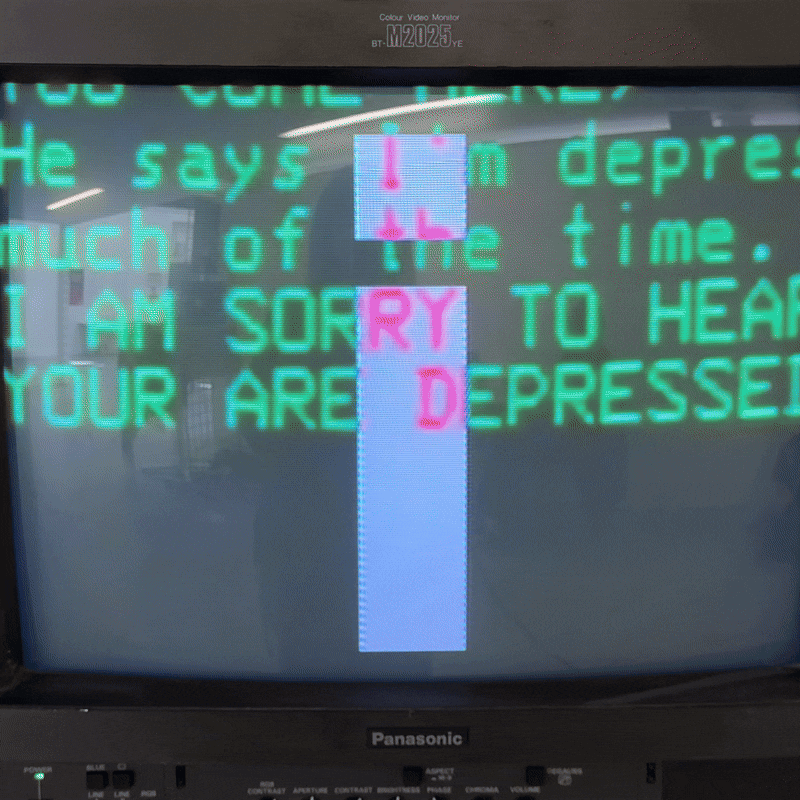MDes Sound for the Moving Image School of Innovation & Technology
Kirsten Farquhar

Kirsten Farquhar is a Scottish audiovisual artist who takes a multidisciplinary approach to experimental film and sound design.
Her practice explores the rapidly evolving technological landscape, with a particular focus on advancements in Artificial intelligence (AI), and the shifting boundaries between humans and machines.


I GENERATE THEREFORE i SEEM
WARNING: This film contains FLASHING IMAGES ⚠️
Artificial Intelligence (AI) has woven itself seamlessly into our everyday lives. From one of the earliest chatbots, ELIZA, developed by Joseph Weizenbaum back in 1966, to the current day boom of AI users across countless platforms, with ChatGPT notably boasting around 190.6 million users daily as of August 2025 (Singh, 2025), these technologies have evolved from simple data/rule-based programs into powerful systems that are now capable of generating convincing visuals, text, and the ability to interact and communicate with us, all from devices that can fit right into our pockets. This significant shift in technological progress, from experimental programs to tools that now play an integral role in our daily lives, invites the increasing demand for a deeper exploration and understanding of their impact. The potential of Artificial Intelligence is often caught between the tension of seeming and being, and with its development becoming exceedingly more prominent, the question of what it means to be in the age of AI is brought sharply into a contemporary focus.
Throughout my research I examined how philosophical, cultural and creative frameworks can help us navigate this shifting terrain. By building upon René Descartes’ foundational statement Cogito ergo sum (“I think, therefore I am”), this research reframes this proposition through a modern lens, exploring the appearance of thought or existence with regards to AI, how it can only be portrayed seemingly, and how AI generated “thinking” cannot constitute towards true consciousness or being. Through further exploration into other philosophical concepts such as Jean Baudrillard’s theory of simulacra, the allegory of Plato’s cave, as well as analysing ethical and societal anxieties portrayed throughout a selection of contemporary audio-visual works, this research aims to interrogate the shifting boundaries between representation and reality.
● ● ●
I GENERATE THEREFORE I SEEM (2025), is an experimental film which reimagines Descartes’ assertion, “I think therefore I am,” to question whether AI’s appearance of thought or existence equates to consciousness or being. At the same time, this film serves as a reminder of what AI cannot replicate; embodied experience, free will, and the capacity to live and feel. Through rapid, flash-cut style visuals and spatialised audio, this film juxtaposes intimate human moments with the looming presence of AI, pushing the boundaries between seeming and being.
🎧 Headphones Recommended
Postgraduate Degree Show Installation
Documentation of, I GENERATE THEREFORE i SEEM (2025), being displayed at the Haldane Building as part of the School of Innovation & Technology Postgraduate Degree Show (August 28th – August 31st 2025).
My decision to present my film on a 19″ Vintage Panasonic CRT monitor was to reinforce the film’s dialogue between the human relationship with machines. By situating my work within a medium associated with earlier eras of digital culture, the analogue flicker and weight of the monitor evokes a sense of nostalgia, recalling the Windows ’98 campaign, “Where Do You Want To Go Today?” This contrast with AI’s intangible form highlights the film’s central concerns of what it means to seem versus what it means to be.
POV: Inside the family computer
The concept for this spatial audio project is to create an immersive audio experience which explores abstract, intangible spaces and how the use of spatial audio can bring these spaces to life. This concept not only allowed me to explore the ways that spatial audio can transport listeners into imagined environments, but also its emotional effects on creating and immersive experience for a space that is otherwise inaccessible or impossible to experience directly. For this project I have created a soundscape from the perspective of being inside a computer, in which this internal perspective became a way to explore our relationship with machines, digital consciousness and machine spirit, and the nostalgia we often associate with outdated technology.
🎧 Headphones Recommended
Computer (Generative Supercut Film)
Campaigns such as Microsoft’s Windows 98 ads were bursting with enthusiasm and optimism, showcasing a vision of the future where technology would empower and connect humanity. The fast-paced, colourful visuals and triumphant music embodied the collective excitement about the dawn of the digital age, and being able to look back on these ads throughout my research has evoked a sense of nostalgia and longing for a time when technology’s promise felt thrilling and untainted.
Despite this, I can’t help but feel as though this optimism is now shadowed by unease, as our contemporary experience of technology often includes concerns over surveillance, automation, isolation, and disconnection. As mentioned in Polly Wyn Jones’ article, Take me back: The power of Nostalgia In Advertising, playing with nostalgia in modern advertising can forge deep emotional connections, making products more appealing by tapping into consumers’ fond memories and positive associations with the past (Jones, 2023). The glossy futurism of these ads now take on a surreal, almost uncanny quality, reflecting the gap between the promise of the past and the reality of the present.
Using MAX (a visual programming language for music and multimedia developed and maintained by San Francisco-based software company Cycling ’74), the aim for this generative supercut is to recontextualise these early tech ads to explore the duality of awe and unease throughout our relationship with technology. By layering nostalgic imagery along with disruptive sounds and glitches, this piece critiques the utopian promises of these ads, while reflecting on the complex emotions they now evoke.
Sound Redesign of PERSONA (1966)
GRAPHIC CONTENT: GORE, VIOLENCE
My approach to this project started with the decision to eliminate all expectations about this film by blind reacting to the silent visuals first. By going through the sequence fragment by fragment, the ideas for my sound redesign were guided solely through the emerging themes and symbolism based on my own interpretations.
The foundation for my sound redesign was greatly inspired by the sequence’s variety of perplex visual motifs. The spider, which is often associated with various connotations such as, persistence, creation, inter-connectivity, fear, and entrapment. The child, and the way they contrast with the elderly characters who appear in the morgue/hospice like scenes also stood out to me. The child reflects the inevitability of time passing and the awareness of one’s mortality, but also brings a sense of childlike innocence and vulnerability. The church-like buildings, the crucifixion scene, and various other religious imagery give the sequence a ritualistic and existential tone.
I also got the impression that Persona presents itself as a film within a film. Opening with the depiction of film reels and the projector that progressively flick through the fragmented scenes reinstate the ideas of time and mortality. Furthermore, this idea of a “film within a film” blurs the boundaries of reality, allowing the opportunity to explore and challenge the dreamlike and enigmatic nature of the visuals to create a soundscape which feels both immersive yet unnerving.
Original Film – Persona (1966) directed by Ingmar Bergman.
(Available to watch via The Internet Archive)
The Glasgow Harbour Tunnel
For my Clyde Built project, I decided to explore the Glasgow Harbour Tunnel, an underground relic that once symbolized a thriving era, now left to the ravages of time…
Glasgow’s unique variety of architecture is always fascinating to indulge and delve into. Every building, from industrial grit to Victorian grandeur, captures the city’s vibrant spirit and rich history. The Glasgow Harbour Rotundas for example, two buildings parallel to one another that stand watch over the River Clyde, they blend into the background of the city’s landscape. Traveling past these unique, domed roofed, circular structures on the bus piqued my curiosity, and having only imagined the significance of these identical structures, discovering their purpose had me taken aback. A fragment of history abandoned to deteriorate in silence beneath the busy streets and the Clyde’s tides.
The story of the rotundas is one of connection and ambition, and a time when industry, innovation, and ambition shaped the city’s soul. Built in 1895, the rotundas once marked the entrance to a tunnel beneath the Clyde, an underground passage that helped the workers and citizens of Glasgow traverse the river during the city’s industrial boom. The tunnel was a marvel of engineering in its day, featuring two large ventilation shafts and hydraulic lifts, originally intending to transport horse-drawn carriages and pedestrians, then later adapted to motor vehicles. Brick and cast-iron segments were used in the construction of the tunnel, which were 720 feet long between the shafts and 16 feet in diameter. The vehicle tunnels were closed in 1943 due to the removal of metal and the vehicle lifts to contribute to the war effort. Later, the completion of Bell’s Bridge in 1986 subsequently marked the end of the Glasgow Harbour tunnel, with the pedestrian tunnel closure in 1987 due to safety concerns and declining use.
The reverberated sounds were heavily inspired by a quote by a columnist for the Evening Citizen who recalls a trip beneath the Clyde in 1932:
❝ The door of the passenger tunnel has long been disused, and foot-passengers now enter by one of the four elevators for vehicles at the other side of the rotunda. Choosing the company of a horse and lorry as preferable to that of a motor-car, I soon found myself smoothly and quietly descending among a bewildering medley of wheels and cables, through which I could see the mouth of the old disused foot-passenger tunnel as we passed on the way down. At the bottom water oozed through the iron sides of the great tube, which has never been totally watertight. At one place a single stalactite a font long hung from the roof, ❞ (Johnstone and Halliday, 2004).

































